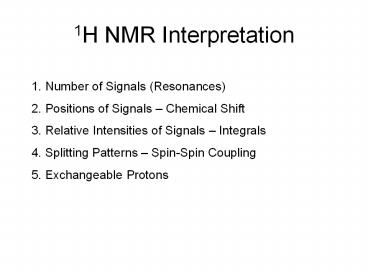1H NMR Interpretation - PowerPoint PPT Presentation
Title:
1H NMR Interpretation
Description:
1H NMR Interpretation Number of Signals (Resonances) Positions of Signals Chemical Shift Relative Intensities of Signals Integrals Splitting Patterns Spin ... – PowerPoint PPT presentation
Number of Views:85
Avg rating:3.0/5.0
Title: 1H NMR Interpretation
1
1H NMR Interpretation
- Number of Signals (Resonances)
- Positions of Signals Chemical Shift
- Relative Intensities of Signals Integrals
- Splitting Patterns Spin-Spin Coupling
- Exchangeable Protons
2
Number of Signals Simple Cases
3
Number of Signals and Stereochemistry
- Watch out when you have rings and/or douuble
bonds! To determine equivalent protons in
cycloalkanes and alkenes, always draw all bonds
to hydrogen.
4
Number of Signals in a Cyclic Compound
- Proton equivalency in cycloalkanes can be
determined similarly.
5
Positions of Signals - Local Diamagnetic Shielding
6
Positions of Signals Induced Anisotropic
Shielding - Benzene
- In a magnetic field, the six ? electrons in a
benzene ring circulate around the ring creating a
ring current. - The magnetic field induced by these moving
electrons reinforces the applied magnetic field
in the vicinity of the protons. - The protons feel a stronger magnetic field and
thus are deshielded. A higher frequency is needed
for resonance.
7
Positions of Signals Induced Anisotropic
Shielding - Alkene
- In a magnetic field, the loosely held ? electrons
circulate creating a magnetic field that
reinforces the applied field in the vicinity of
the protons. - Since the protons now feel a stronger magnetic
field, they require a higher frequency for
resonance. Thus the protons are deshielded and
the absorption is downfield.
8
Positions of Signals Induced Anisotropic
Shielding - Alkyne
- In a magnetic field, the ? electrons of a
carbon-carbon triple bond are induced to
circulate, but in this case the induced magnetic
field opposes the applied magnetic field (B0). - Thus, the proton feels a weaker magnetic field,
so a lower frequency is needed for resonance. The
nucleus is shielded and the absorption is upfield.
9
Summary of pi electron effects
10
Positions of Signals Characteristic Shifts
11
Intensity of Signals
- The area under an NMR signal is proportional to
the number of absorbing protons. - The integral ratios tell us the ratios of the
protons causing the peak. - Strategy - find a peak that you can assign
unambiguously and set its integral at the
appropriate number of Hs.
12
Splitting Patterns
- Consider the spectrum below
13
Theory of spin-spin splitting
- Spin-spin splitting occurs only between
nonequivalent protons on the same carbon or
adjacent carbons.
Let us consider how the doublet due to the CH2
group on BrCH2CHBr2 occurs
14
Doublet
The frequency difference, measured in Hz between
two peaks of the doublet is called the coupling
constant, J.
15
Triplet
Let us now consider how a triplet arises
- When placed in an applied magnetic field (B0),
the adjacent protons Ha and Hb can each be
aligned with (?) or against (?) B0. - Thus, the absorbing proton feels three slightly
different magnetic fieldsone slightly larger
than B0, one slightly smaller than B0, and one
the same strength at B0.
16
Triplet
17
Peak ratios in a multiplet.
- Doublet The two spin states of the proton
causing splitting are nearly equally populated
(because the energy difference is so small).
Therefore a doublet is has a peak ratio of 11. - Triplet - Because there are two different ways
to align one proton with B0, and one proton
against B0that is, ?a?b and ?a?bthe middle peak
of the triplet is twice as intense as the two
outer peaks, making the ratio of the areas under
the three peaks 121. - Higher use Pascals triangle
18
Multiplet names
19
Rules for predicting splitting patterns
- Equivalent protons do not split each others
signals. - A set of n nonequivalent protons splits the
signal of a nearby proton into n 1 peaks. - Splitting is observed for nonequivalent protons
on the same carbon or adjacent carbons.
If Ha and Hb are not equivalent, splitting is
observed when
20
(No Transcript)
21
Nuclear Magnetic Resonance Spectroscopy
1H NMRSpin-Spin Splitting
Whenever two (or three) different sets of
adjacent protons are equivalent to each other,
use the n 1 rule to determine the splitting
pattern.































